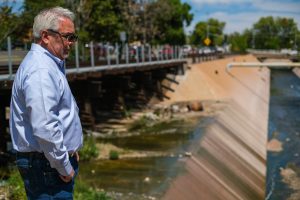- Slug: BC-CNS-Nogales Fair Treatment. 870 words.
- 3 photos and captions below.
- Graphic by Quindrea Yazzie here.
By CHLOE JONES
Cronkite News
NOGALES – More than 370 articles on the Nogales International online news archive contain the word “sewage,” and that archive only dates to 2001. These articles reveal a long history of broken pipes, sewage overflows, industrial waste and more.
Sewage in Ambos Nogales – “ambos” is Spanish for “both,” referring to the twin cities in Arizona and Sonora – has been an issue since 1944, when the first binational treaty regarding water sanitation was signed by the International Boundary and Water Commission.
One long-running problem involves a pipeline – the International Outfall Interceptor – that transports sewage from both sides of the border to the Nogales International Wastewater Treatment Plant near Rio Rico. Authorities can’t agree on how to maintain, operate and pay for this binational infrastructure.
But officials with Nogales, Arizona, say they’re being treated unfairly by the commission, which assesses Nogales nearly a quarter of the costs even though more than 90 percent of the sewage comes from Mexico. They argue that water sanitation at the border is a federal issue, and they’ve turned to Congress to ensure equitable treatment before the commission.
“It’s not one country’s fault more than another country’s fault. You know, it doesn’t make a difference. The sewage is going to come either way,” said John Kissinger, a lifetime resident of Nogales. “We can blame each other all we want, but it’s coming.”
Kissinger has worked for the city since 1981, first as a police officer and now as deputy city manager. He said his hometown has had issues with sewage from Mexico for as long as he can remember.
“If Mr. Trump closes the border, this all stops but the sewage keeps flowing,” said Kissinger, pointing to the string of produce warehouses and semitrailers along Interstate 19, which links Tucson and Nogales.
“We all need water, and we all need clean, safe water. And so I don’t feel threatened by a border crisis of immigrants,” said Ben Lomelí, a hydrologist for Friends of the Santa Cruz River, a nonprofit that aims to protect the integrity of the Nogales Wash and the river it feeds. “I feel that our communities are much more threatened by contamination sources at this point in time.”
Under the Treaty of 1944, the International Boundary and Water Commission, or IBWC, is supposed to give preferential attention to water sanitation issues along the southern border. Nogales officials don’t think the IBWC is doing so fairly, and with the help of Sen. Kyrsten Sinema, D-Ariz., the city is proposing the Nogales Fairness Act.
The proposed legislation would hold the commission accountable to share costs, operations and maintenance of the international wastewater plant and binational pipeline equitably.
The environmental challenges
The International Outfall Interceptor, or IOI, is the only binational pipeline on the southern border. Sewage piping is gravity fed, so the pipe runs north from Sonora into Arizona along the Nogales Wash because the elevation on the Mexican side is higher than the U.S. side.
The IOI, like most sewage pipes, is made out of slip joints, which connect two pieces of piping without welding or adhesives.
“It works perfectly fine when it’s just flowing like a normal stream of sewage,” Kissinger said. “What happens, though, if you put sewage into it, and it’s overcharging it, it pulls those two pieces apart.”
The pipeline often gets overcharged during peak flows and monsoons.
Sewage contaminated with heavy metals and other industrial pollutants have been found leaking from the interceptor into the Nogales Wash, and eventually the Santa Cruz River. These pollutants, which damage the pipe, come from Mexico, Kissinger said, because Nogales, Arizona, has no industrial factories.
The financial concern
The IBWC estimates repairs to the first third of the IOI will cost $27 million and wants to charge Nogales a 23 percent “local match,” or about $6 million. It’s a problem and a number that Nogales does not feel responsible for.
“They’re (the IBWC) the ones who by treaty receive, convey and treat Mexican sewage, not us,” Kissinger said. “By law. We can’t. The only ones who can have an arrangement or an agreement with a foreign country is the federal government.”
Nogales, Arizona already pays for 23 percent of the operation and maintenance of the Nogales International Wastewater Treatment Plant, despite contributing just 8 percent of the sewage treated.
Kissinger said the commission has been charging the city 23 percent since at least 2007 without explaining how this number came to be.
“If we take the percentage of that 7 percent of the population of both Nogales’ is Nogales, Arizona, and 93 percent of the population of Ambos Nogales is from Nogales, Mexico,” Kissinger said. “How ironic is it that it correlates to flows? Ninety-two percent of the flows is Mexican and 8 percent (is from Arizona). So you could almost say flow per people, right?”
Nogales is asking Arizona legislators to support a resolution for the proposed Nogales Fairness Act. Sinema’s office has not said when she will introduce the bill.
“We’re not building a park. We’re not building highways,” Kissinger said. “This is a federal problem that the city of Nogales should not be on the hook for. And by any chance we should be on the hook, it’s definitely not for 23 percent.
For more stories from Cronkite News, visit cronkitenews.azpbs.org.
^_=


